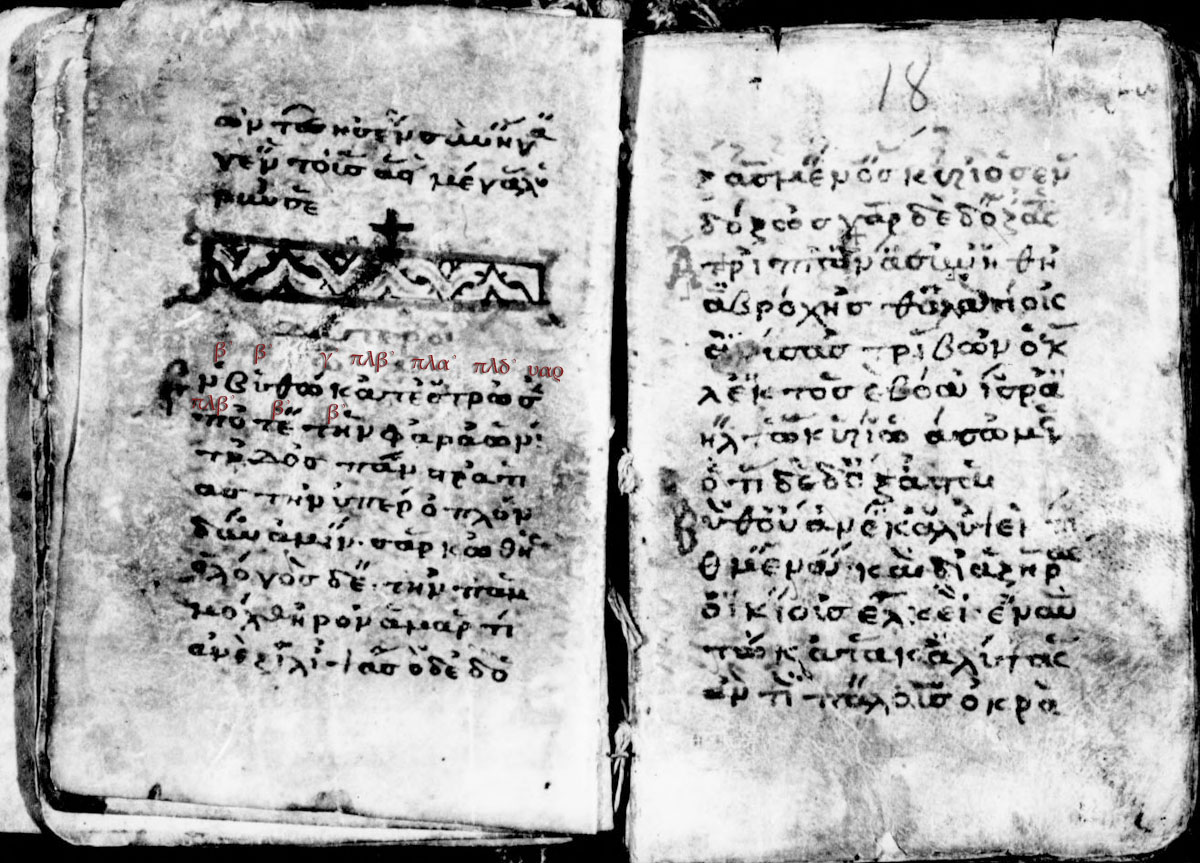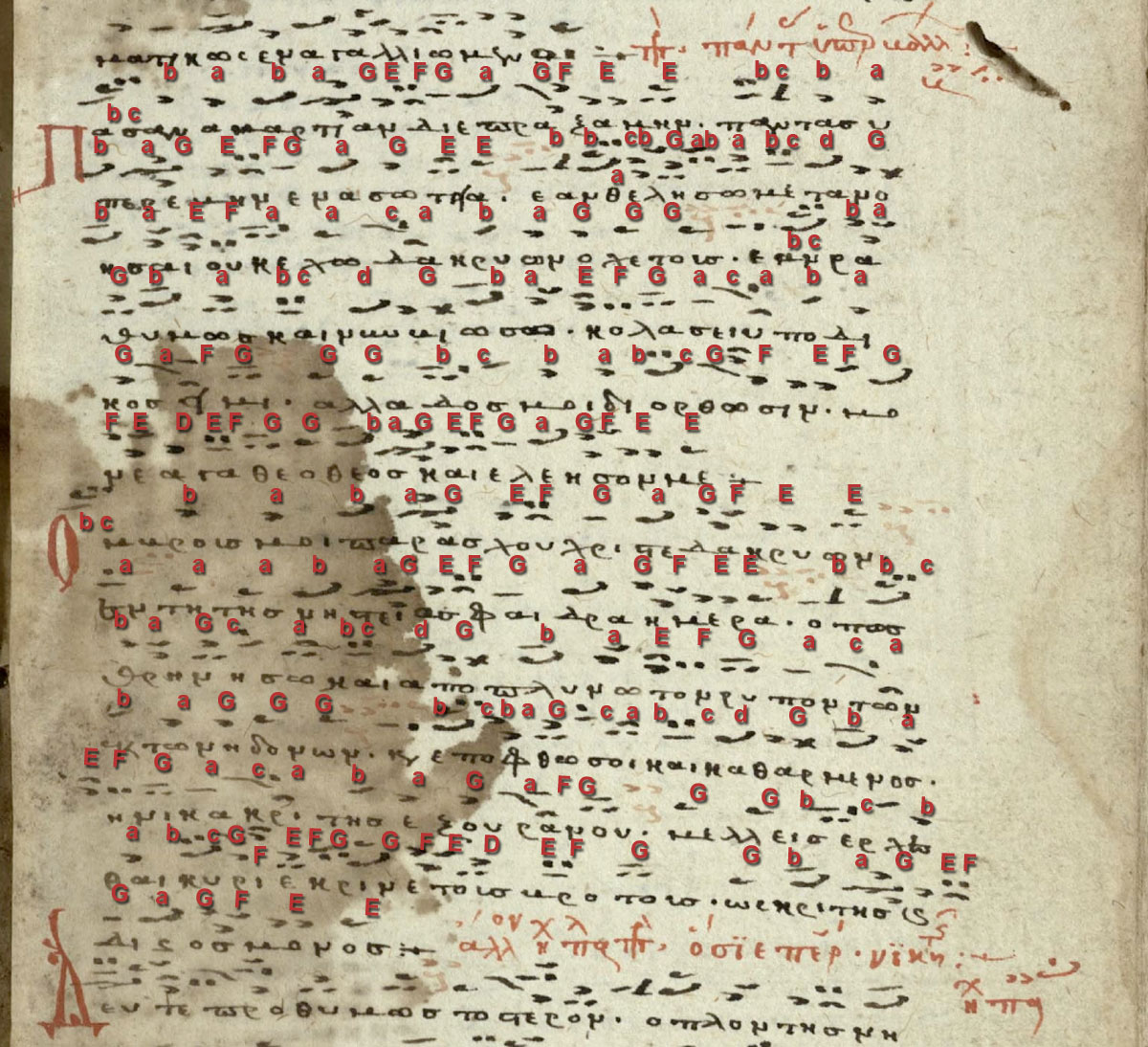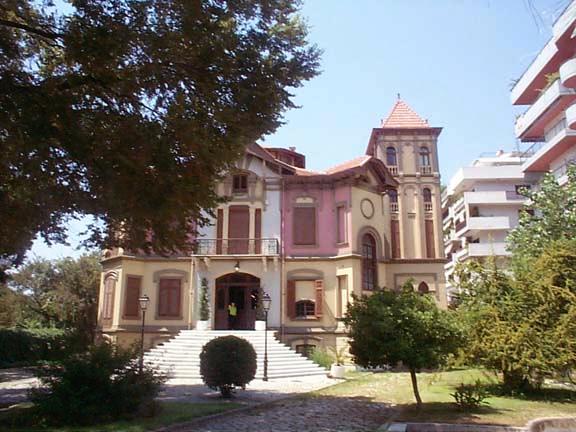|
Heirmologion
Irmologion ( ) is a liturgical book of the Eastern Orthodox Church and those Eastern Catholic Churches which follow the Byzantine Rite. It contains irmos, ''irmoi'' () organised in sequences of odes (, sg. ) and such a sequence was called canon (hymnography), ''canon'' ( 'law'). These canons of nine, eight, four or three odes are supposed to be chanted during the morning service (Orthros). The book ''Irmologion'' derives from ''irmos, heirmos'' () which means 'link'. The is a melodic model which preceded the composition of the odes. According to the etymology, the book 'collects' ( ) the . The melodic irmos and the odes of the canon and its use during the morning service An important portion of Matins and other services in the Orthodox Church is the Canon (hymnography), canon, a long liturgical poem divided into nine strophes with a sophisticated meter called ode. Each ode and its prosodic meter is made according to a certain irmos, and concerning its celebration during Orthro ... [...More Info...] [...Related Items...] OR: [Wikipedia] [Google] [Baidu] |
Petros Peloponnesios
Petros Peloponnesios ("Peter the Peloponnesian") or Peter the Lampadarios (c. 1735 – 1778) was a cantor, composer and teacher of Byzantine and Ottoman music. He must have served as second ''domestikos'' between his arrival about 1764 until the death of Ioannes Trapezountios, and it is assumed that he became '' lampadarios'' (leader of the left choir) between 1770 and 1778 at the Great Church of Constantinople, after Daniel the Protopsaltes became Archon Protopsaltes. Large parts of the monodic chant sung in several current traditions of Orthodox Chant are transcriptions of his compositions. He wrote these as a teacher of the "New Music School of the Patriarchate". Life Petros was born at Tripolis, Rumelia Eyalet between 1730 and 1740. According to Georgios Papadopoulos he was educated in monastic communities of Smyrna. In 1764 he came to Constantinople to study with Ioannes Trapezountios, the Archon Protopsaltes, while Daniel like Ioannes student of Panagiotes Halacoğlu was Lam ... [...More Info...] [...Related Items...] OR: [Wikipedia] [Google] [Baidu] |
Petros Bereketis
Petros Bereketis () or Peter the Sweet (Πέτρος ο Γλυκής) was one of the most innovative musicians of 17th-century Constantinople (Ottoman period). He, together with Panagiotes the New Chrysaphes, Balasios the Priest and Germanos Bishop of New Patras was one of the most influential figures in the evolution of the Byzantine music, Byzantine psaltic art following the fall of Constantinople in 1453, although he never was associated with the Patriarchate in Fener. For many years, he served as the protopsaltis (first cantor) of the parochial church St. Constantine of the Samatya, Hypsomatheia (Samatya) quarter close to the Sea of Marmara, Marmara coast. During his lifetime, which is approximately supposed to be between 1665 and 1725, while Chrysanthos mentioned that he served there in the time of the Archon Protopsaltis at the Ecumenical Patriarchate of Constantinople, Great Church of Christ of Panagiotis Halatzoglou and his Lampadarios John Trapezountios (1727–1748). Ed ... [...More Info...] [...Related Items...] OR: [Wikipedia] [Google] [Baidu] |
Byzantine Rite
The Byzantine Rite, also known as the Greek Rite or the Rite of Constantinople, is a liturgical rite that is identified with the wide range of cultural, devotional, and canonical practices that developed in the Eastern Christianity, Eastern Christian church of Constantinople. The canonical hours are extended and complex, lasting about eight hours (longer during Great Lent) but are abridged outside of large Monastery, monasteries. An iconostasis, a partition covered with icons, separates Sanctuary#Sanctuary as area around the altar, the area around the altar from the nave. The Sign of the cross#Eastern Orthodoxy, sign of the cross, accompanied by bowing, is made very frequently, e.g., more than a hundred times during the Divine Liturgy#Byzantine Rite, divine liturgy, and there is prominent veneration of icons, a general acceptance of the congregants freely moving within the church and interacting with each other, and distinctive traditions of liturgical chanting. Some traditional ... [...More Info...] [...Related Items...] OR: [Wikipedia] [Google] [Baidu] |
Liturgical Book
A liturgical book, or service book, is a book published by the authority of a church body that contains the text and directions for the liturgy of its official Church service, religious services. Christianity Roman Rite In the Roman Rite of the Catholic Church, the primary liturgical books are the Roman Missal, which contains the texts of the Mass (liturgy), Mass, and the Roman Breviary, which contains the text of the Liturgy of the Hours. With the Mass of Paul VI, 1969 reform of the Roman Missal by Pope Paul VI, now called the "Ordinary Form of the Roman Rite", the selection of Scriptural readings was expanded considerably and thus required a new book called the Lectionary. The Roman Ritual contains the texts for administering some Sacraments of the Catholic Church, sacraments other than the Mass (liturgy), Mass such as baptism, the Sacrament of Penance (Catholic Church), sacrament of penance, the Anointing of the Sick (Catholic Church), anointing of the sick, and the sacram ... [...More Info...] [...Related Items...] OR: [Wikipedia] [Google] [Baidu] |
Avtomela
(Medieval Greek: from , 'unique' and , 'melody'; Church Slavonic: , )—pl. ''idiomela''—is a type of sticheron found in the liturgical books used in the Eastern Orthodox Church, the Eastern Catholic Churches which follow the Byzantine Rite, and many other Orthodox communities like Old Believers. are unique compositions, while or —sing. , or (Medieval Greek: , Church Slavonic: , )—were used to create other hymns by a composition over the 's melody and following the poetic meter provided by the musical rhythm. The genre composed over these was characterised as or (Medieval Greek: 'similar to', Church Slavonic: , ). Definition of ''idiomelon'', ''avtomelon'' and ''prosomoion'' The hymn category can only be understood in comparison with and . Already in the older book Tropologion each melody of a certain hymn was classified by a modal signature of the Byzantine octoechos—the eight-mode system as it had developed in Constantinople, Damascus, Jerusalem, and in ma ... [...More Info...] [...Related Items...] OR: [Wikipedia] [Google] [Baidu] |
Troparia
A troparion (Greek , plural: , ; Georgian: , ; Church Slavonic: , ) in Byzantine music and in the religious music of Eastern Orthodox Christianity is a short hymn of one stanza, or organised in more complex forms as series of stanzas. The wider meaning of troparion The word probably derived from a diminutive of the Greek ('something repeated', 'manner', 'fashion'), since the earliest function of the troparion was a refrain during the recitation of the cantica (biblical odes) and the psalms, as such the term was used as a synonym of . The early meaning of ''troparion'' was related to the monastic hymn book '' Tropologion'' or Troparologion. Hence its forms were manifold, they could be simple stanzas like apolytikia, theotokia, but also more elaborated homiletic poems like ''stichera'' composed in psalmodic hexameters (probably from ''stichos'', "verse"), or in a more complex meter like the odes composed in cycles called canon. Since these Tropologia in their earliest form we ... [...More Info...] [...Related Items...] OR: [Wikipedia] [Google] [Baidu] |
Syriac Sertâ Book Script
Syriac may refer to: * Suret, a Neo-Aramaic language * Syriac alphabet, a writing system primarily used to write the Syriac language ** Syriac (Unicode block) ** Syriac Supplement * Syriac Christianity, a branch of Eastern Christianity * Syriac language The Syriac language ( ; ), also known natively in its spoken form in early Syriac literature as Edessan (), the Mesopotamian language () and Aramaic (), is an Aramaic#Eastern Middle Aramaic, Eastern Middle Aramaic dialect. Classical Syriac is ..., an Eastern Middle Aramaic dialect * Syriac literature, literature in the Syriac language * Syriac studies, the study of the Syriac language and Syriac Christianity * Syriacs (term), term used as designations for Syriac Christians * Syriac people, another term for Assyrian people See also * * Syriac Rite * Syrian (other) * Syria (other) * Suriyani {{disambiguation Language and nationality disambiguation pages ... [...More Info...] [...Related Items...] OR: [Wikipedia] [Google] [Baidu] |
Armenian Language
Armenian (endonym: , , ) is an Indo-European languages, Indo-European language and the sole member of the independent branch of the Armenian language family. It is the native language of the Armenians, Armenian people and the official language of Armenia. Historically spoken in the Armenian highlands, today Armenian is also widely spoken throughout the Armenian diaspora. Armenian is written in its own writing system, the Armenian alphabet, introduced in 405 AD by Saint Mesrop Mashtots. The estimated number of Armenian speakers worldwide is between five and seven million. History Classification and origins Armenian is an independent branch of the Indo-European languages. It is of interest to linguists for its distinctive phonological changes within that family. Armenian exhibits Centum and satem languages, more satemization than centumization, although it is not classified as belonging to either of these subgroups. Some linguists tentatively conclude that Armenian, Greek ... [...More Info...] [...Related Items...] OR: [Wikipedia] [Google] [Baidu] |
Georgian Language
Georgian (, ) is the most widely spoken Kartvelian language, Kartvelian language family. It is the official language of Georgia (country), Georgia and the native or primary language of 88% of its population. It also serves as the literary language or lingua franca for speakers of related languages. Its speakers today amount to approximately 3.8 million. Georgian is written with its own unique Georgian scripts, alphabet, alphabetical systems of unclear origin. Georgian is most closely related to the Zan languages (Megrelian and Laz language, Laz) and more distantly to Svan language, Svan. Georgian has various dialects, with standard Georgian based on the Kartlian dialect, and all dialects are mutually intelligible. The history of Georgian spans from Early Old Georgian in the 5th century, to Modern Georgian today. Its development as a written language began with the Christianization of Georgia in the 4th century. Georgian phonology features a rich consonant system, including aspi ... [...More Info...] [...Related Items...] OR: [Wikipedia] [Google] [Baidu] |
National Bank Of Greece Cultural Foundation
The Cultural Foundation of the National Bank (, ''Morfotiko Idryma Ethnikis Trapezis'', MIET) is a cultural foundation based in Athens founded in 1966. The Foundation was established under the administration of Georgios Mavros, as part of the 125th anniversary celebrations of the National Bank of Greece, which decided to create a cultural foundation to support the humanities, arts and sciences. After interruption during the Greek military junta of 1967–1974, the Foundation recommenced its activities in 1974, again under the sponsorship of Georgios Mavros, then Centre Union – New Forces leader and Deputy Prime Minister of Greece. Historical and Palaeographical Archive Among MIET's principal projects is the Historical and Palaeographical Archive (Ιστορικό και Παλαιογραφικό Αρχείο) on Panagi Skouze St., Athens. The archive aims to establish a microfilm archive of manuscript codices and historical archives from Greek-speaking lands, conduct research and ... [...More Info...] [...Related Items...] OR: [Wikipedia] [Google] [Baidu] |





